|
If someone told me that I was being lied to on a daily basis by various people, organizations, signage, and advertising, my knee-jerk reaction is no thanks, I'd rather have the truth. Nobody wants to find out they've been tricked. But every day we are bombarded by white lies that I for one am happy to keep. The truth is no one wants to find out they've been tricked, but the tricking often isn't the problem - the finding out is.
Example: I recently saw an article that said that the oscars are not about awarding cinematic accomplishments, but about controlling our view of cinema - basically that the oscars always has an agenda, and apparently this year it's awarding young stars in hopes of elevating them to the level of more mature performers. I have no problem with that on an ethical level, but I wasn't pleased to see the article because I liked living in a world where the Oscars give out awards to the best people, period. I suppose I like living in a world of absolutes. Take another example: I used to work in a bookstore that displayed the top 40 bestsellers for the store each week. For a while I always assumed that they were the top 40 bestsellers, until I saw the process for choosing the bestsellers. That's right, choosing. Again, I think the ethics in this situation were sound. All the books we listed in the top 40 were at least in the top 50 or 60, but some books got bumped off the list - for example, if a book was assigned for a class, so lots of students came in that week and bought it, it might be bumped off the list since those sales weren't a true reflection of the book's popularity. Also, books that were already extremely popular across the nation, and on the trashy side, were taken off the list because the bookstore didn't need or want to promote them. By omitting these books, some local or less well known books that had done well but were only #48 or #56 would get the opportunity to be promoted by the store - and isn't that what best seller lists are for? To help you discover something popular that you hadn't heard of? The top 40 was never literally the top 40 best selling books, but it was close enough, and I think the customers of that store were living in a happier world with the revised top 40 of solid recommendations. This tradition of white lies to preserve a more optimistic view of the world extends to personal relationships of course. We all know the rule about complimenting friends and lovers and saying the dress doesn't make her look fat or whatever. But the lies even go as deep as our feelings for each other, and I'm okay with that. If you find yourself in a relationship that lasts longer than 2 months, chances are great that you won't feel the love every day as intensely as you did those first days. You may find that you love your partner about 6 days of the week, and spend a solid day or so feeling neutral about them, or bored, or even not thinking about them. What a sad thought, right? That's why it's another example of a truth I'd rather do without, and be happier pretending it isn't so.
0 Comments
I'm reading Tom Rachman's The Imperfectionists. About halfway through the book, two characters are debating whether or not everyone's actions are selfishly motivated, that maybe good people are only good because they want to feel like good people, and that counts as a self-centered motivation. Within this discussion, one character asks the other, "So why do you kiss someone? To give pleasure or to take it?" I wasn't planning on thinking about this point for very long. I was almost satisfied with simply thinking, "aw, snap!" and moving on to the next paragraph, but then my brain switched on because the posed question is a combination of two of my favorite things: critical thinking and mushy romantic shit. At first it seemed shamefully obvious that the answer was the latter. I kiss because I want to. We all kiss because we want the erotic pleasure of our mouth on another's mouth (or other body part). So we kiss to take pleasure. But with only a little more thought, it becomes clear that A) there are other ways of kissing besides erotically, almost all of which are to express love, be it romantic, friendly, of familial, and B) even with erotic kissing, a kiss cannot truly be be enjoyed without the kissee deriving pleasure from the kiss as well (unless one is sadistic, and for our purposes we are assuming one is not)--in fact, it is the same in case A; love is not so well expressed or enjoyed if it is not mutual. And it is only in unfortunate circumstances (or, I suppose, circumstances of prostitution) that one is kissing for the purpose of giving pleasure, but not to receive it (we'll file such circumstances, along with sadism, under "things we will ignore for our purposes). So, unlike so many other things in life, kissing falls under the category of mutual give and take, a perfect example of an act that (except for those few circumstances we are ignoring) breaks open the "selflessness is selfish" argument.* It can only be properly executed by both parties simultaneously wanting to give and accept the gift of physical intimacy. And if your mind is mechanical in the same way mine is, you can see that a kiss is the definition of love. Cue "The Shoop Shoop Song." ** * Devil's advocates: I'm sure if you wanted to debate this with me, we could. Heck, I could debate this with me. But in the end, kissing is awesome, so shuddap.
** Actually, I will cue "The Shoop Shoop Song," because it's an awesome song. Here: I know I'm a little behind the times, but I started reading Tina Fey's Bossypants today, and I'm obviously loving it. In it she talks about the moment that a woman knows she is a woman, and that almost all of the women she discussed this with discovered their womanhood via a man yelling at them from a car - that there were no positive experiences of discovering womanhood. My first reaction was that this seemed strange. I don't remember the exact moment that I felt like a woman instead of a little girl, and I am pretty sure it had something to do with being interested in boys, or noting their interest in me, but I think for me it was a positive experience. It certainly had nothing to do with being shouted at from a car window.
As someone who, nowadays, gets shouted at on the fairly regular by boys in cars etc, it seemed weird to realize that this only started about halfway through college for me. Was I not worthy of being shouted at until I was 20? No, I don't think that's it - being shouted at has little to do with one's worthiness, and more to do with the shouter. So what was different about potential shouters before I was 20? I knew them all. Yup, until I was 20 I lived in quite a small town. I grew up in Glover, VT, where the population is just under 1000. That's right, a number so low I don't even have to put a comma in it if I don't want to. Everyone knew everyone. And for my first 3 semesters of college, I lived in Aurora, NY, which has a population of less than 400. It's almost as if any would-be cat-callers in these towns realized that cat-calling is not a very nice thing to do. It wasn't until I moved to Farmington, ME, with a population almost 8 times bigger than the town I grew up in, that I was lucky enough to be shouted at by strangers - and there is the key. True cat-calling needs to be done by strangers to illicit the proper level of creep-out upon the cat-called. It follows in kind that fake cat-calling - like when you whistle to a dear friend that you see in the street - doesn't work if it's anonymous. You can't know your friend is being ironic if you don't know it is your friend. One time when I was walking down the street in Farmington, I did hear someone whistle at me, and then a minute later my friend Mark texted me to say that it had been him doing the whistling from his car, and he felt bad when he'd seen my look around uncomfortably afterwards. In this way, cat calling reminds me of insulting someone behind their back. It's a mean-spirited thing to do. And sometimes I pretend to talk behind my friends' backs, but purposely within their earshot, because what I'm saying is in jest, and what I really mean is "I love you." They get the message if they hear my fake insults, but if they don't hear me even though I meant for them to - well then I am just straight-up being mean behind someone's back, and it doesn't work. In the above scenario, the cat call was taken as mean-spirited until I knew it was really just my friend saying "I love you." Which is kind of fucked up because the insinuation behind a cat-call is usually that the cat-caller is enjoying the existence of the cat-called. That's what they are pretending. But both parties know that it is a creepy thing to do, which is why the cat-caller wants to be anonymous. On that note, I will leave you with Khaela Maricich's interpretation of boys yelling out of car windows: Here is a lesson I learned the hard way and years too late, so I'm gonna tell you all right now: 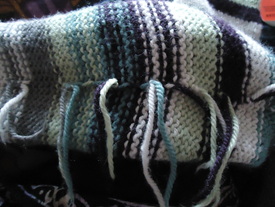 Leave long tails and weave in your ends! You know what I'm talking about - this is the first and last instruction on any knitting pattern. You especially need to do this when changing yarns throughout your work, but, yes, also at the beginning and ends. This is not just because of unsightly knots on scarves - I used to think that if I was knitting a hat or a sweater, that I could just knot the two yarns together on the inside and cut the ends short. Nonononono. This leads to holes and unhappiness and knitted objects of little integrity. I made my mom a sweater for her birthday (or maybe Christmas?) once, and she came to me with it a few months later full of holes! Totally embarrassing, especially since I told her the thing was machine washable - the yarn was fine in the machine, it didn't shrink or bleed, but my shoddy craftsmanship made it not-so-washable. Granted it was made of a particularly slippery yarn and there was a lot of color changing throughout the sweater, but this could happen to just about any piece. 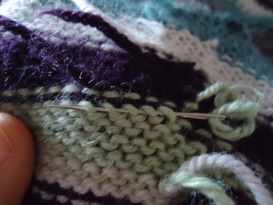 So here is a sort of tutorial, for those, like myself who knit on the fly and might only recently have learned to read patterns an might not have always know what it means to weave in ends and why, and sometimes like to ignore rules when i don't know their purpose. In the above photo is the inside of a sleeve revealing all the naked ends. Remember, leave them long, at least 3 inches, so that they can be threaded into a needle and treated right - you can always trim them (a little) later. To my left here is one of those ends being woven back into the piece. Use a tapestry needle and just go through the tops of a row of stitches, making sure that it doesn't show on the face of the piece. This is pretty easy if you go across a row - if you want to travel down a column of stitches (works well if you are weaving ends into a rib) then you want to skip every other stitch, or it will definitely show on the face of the work; you will essentially just be transfering the end to the front of the work :/ I usually try to weave through a stripe the same color as the yarn end to be double sure. 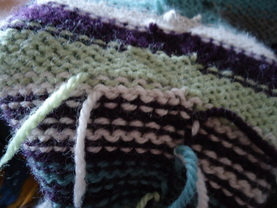 To the right you can see a couple of properly woven ends - green through a green stripe and white through a white stripe. You can also see some already trimmed ends in the top of the picture. And lastly, down below is the finished product - once you've woven the ends through an inch or two of fabric, you have my permission to trim what is left dangling (be careful not to snip and stitches though). Now go forth and be happy knitters, confident in the fact that you are knitting pieces of art that will endure for longer than they would have when you were in that nasty habit of snipping so close to the knots (or was that only me? <3 |
|
All content © Emily Jane Young 2022
Proudly powered by Weebly
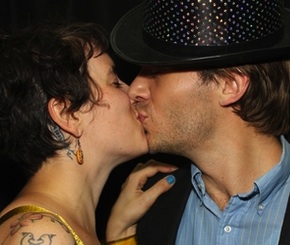
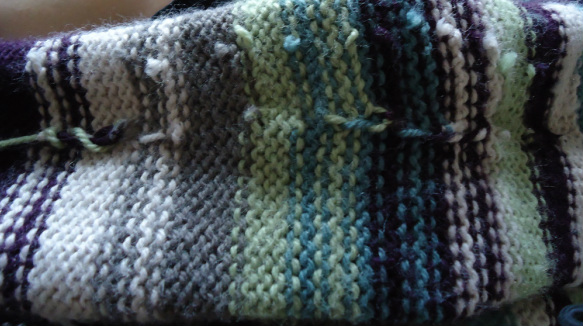
 RSS Feed
RSS Feed